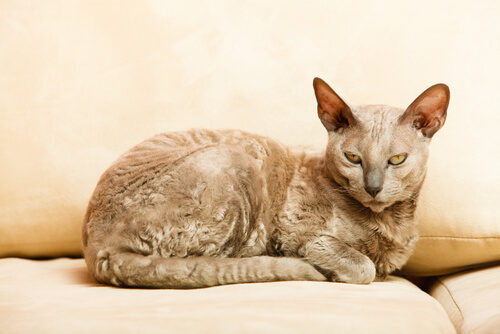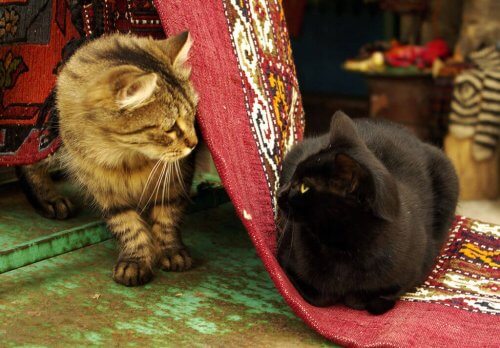What Do Cats Represent in Different Cultures?

Cats are one of the most popular pets in the world. Mysterious and unpredictable, these animals are everywhere. And not just the animals themselves – cat toys, cat figurines, cat garden ornaments, cat clothing… But have you ever wondered what cats represent in different cultures?
Many cultures have used cats as a symbol of something magical and otherworldly. Many even believe that they can bring good fortune. Today, let’s take a look at what cats represent in different cultures around the world, and find out where these beliefs come from.
Cats in different cultures around the world

Compared to dogs, domestic cats are a relatively new part of human life. Humans and dogs have had a close bond for over 35 million years. But the relationship between cats and humans dates back only 9500 years.
So what makes cats so special, and how have they come to hold as important a place in our lives as their canine counterparts, despite the huge differences between them? To find out, let’s take a look at cats in different cultures from around the world.
Ancient Egypt
Some say that the Ancient Egyptians were the first to keep cats as pets, as far back as 3000 B.C. The Egyptians fell in love with their sweet nature, and admired them for their ability to protect them from snakes and rats. As they did with many other animals, they even began to worship cats.
The Ancient Egyptian goddess, Bastet, who represented beauty and fertility, was depicted with the head of a cat. Bastet was a mysterious goddess, who symbolized both the sun and the moon, as well as light and warmth.
The Ancient Egyptians even held state funerals for their cats when they died, performing similar ceremonies to those they used to mark the death of the Pharaohs.
Rome and Greece
The Ancient Greeks fell in love with Egyptian cats, and stole 6 pairs so that they could have their own. By the time they had raised the first few litters, cats had already begun to rise in fame throughout the country, and they began selling them to the Romans, the Galls, and the Celts.
Cats soon spread across the whole of the Mediterranean, creating a huge empire that their owners could only dream of.
In the beginning, cats in ancient Greece were luxury gifts for high-class courtesans rather than pets. The relationship between cats and the Greeks was very different to their relationship with the Romans.
China
In China, people often traded cats for fine silk. Their elegance and hunting prowess won the hearts of the Chinese people. They soon came to be a symbol of love, peace, serenity and good fortune.
In modern China, the cat is seen as a pet exclusively for women. Many people still consider them a symbol of good luck, and a way to drive off evil spirits.
Japan

Their presence in this country dates back to the year 999, when a Japanese emperor received a cat as a gift for his 13th birthday.
While the Japanese believed that cats would attract good fortune, they also believed that the shape of their tails was a symbol of evil. People also came to associate them with feminine grace and elegance, and passed a law to ban the commercialization and confinement of cats.
India
In India, cats are associated with the goddess of fertility, Shashthi, who is often depicted with the face of a cat. They made small statues of cats, using them as lamps and as a deterrent for rodents.
Buddhists thought that they kept away bad spirits, and admired them for their meditative nature. However, in spite of all this, Buddhists don’t consider cats to be sacred.
As you can see, cats are admired and adored in many cultures around the world. Beloved for their elegance, their mysterious air, and their hunting prowess, they are still one of the most popular pets in these cultures today, as well as in many others.
Cats are one of the most popular pets in the world. Mysterious and unpredictable, these animals are everywhere. And not just the animals themselves – cat toys, cat figurines, cat garden ornaments, cat clothing… But have you ever wondered what cats represent in different cultures?
Many cultures have used cats as a symbol of something magical and otherworldly. Many even believe that they can bring good fortune. Today, let’s take a look at what cats represent in different cultures around the world, and find out where these beliefs come from.
Cats in different cultures around the world

Compared to dogs, domestic cats are a relatively new part of human life. Humans and dogs have had a close bond for over 35 million years. But the relationship between cats and humans dates back only 9500 years.
So what makes cats so special, and how have they come to hold as important a place in our lives as their canine counterparts, despite the huge differences between them? To find out, let’s take a look at cats in different cultures from around the world.
Ancient Egypt
Some say that the Ancient Egyptians were the first to keep cats as pets, as far back as 3000 B.C. The Egyptians fell in love with their sweet nature, and admired them for their ability to protect them from snakes and rats. As they did with many other animals, they even began to worship cats.
The Ancient Egyptian goddess, Bastet, who represented beauty and fertility, was depicted with the head of a cat. Bastet was a mysterious goddess, who symbolized both the sun and the moon, as well as light and warmth.
The Ancient Egyptians even held state funerals for their cats when they died, performing similar ceremonies to those they used to mark the death of the Pharaohs.
Rome and Greece
The Ancient Greeks fell in love with Egyptian cats, and stole 6 pairs so that they could have their own. By the time they had raised the first few litters, cats had already begun to rise in fame throughout the country, and they began selling them to the Romans, the Galls, and the Celts.
Cats soon spread across the whole of the Mediterranean, creating a huge empire that their owners could only dream of.
In the beginning, cats in ancient Greece were luxury gifts for high-class courtesans rather than pets. The relationship between cats and the Greeks was very different to their relationship with the Romans.
China
In China, people often traded cats for fine silk. Their elegance and hunting prowess won the hearts of the Chinese people. They soon came to be a symbol of love, peace, serenity and good fortune.
In modern China, the cat is seen as a pet exclusively for women. Many people still consider them a symbol of good luck, and a way to drive off evil spirits.
Japan

Their presence in this country dates back to the year 999, when a Japanese emperor received a cat as a gift for his 13th birthday.
While the Japanese believed that cats would attract good fortune, they also believed that the shape of their tails was a symbol of evil. People also came to associate them with feminine grace and elegance, and passed a law to ban the commercialization and confinement of cats.
India
In India, cats are associated with the goddess of fertility, Shashthi, who is often depicted with the face of a cat. They made small statues of cats, using them as lamps and as a deterrent for rodents.
Buddhists thought that they kept away bad spirits, and admired them for their meditative nature. However, in spite of all this, Buddhists don’t consider cats to be sacred.
As you can see, cats are admired and adored in many cultures around the world. Beloved for their elegance, their mysterious air, and their hunting prowess, they are still one of the most popular pets in these cultures today, as well as in many others.
This text is provided for informational purposes only and does not replace consultation with a professional. If in doubt, consult your specialist.








